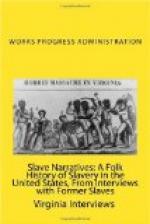Mrs. Hannah Davidson occupies two rooms in a home at 533 Woodland Avenue, Toledo, Ohio. Born on a plantation in Ballard County, Kentucky, in 1852, she is today a little, white-haired old lady. Dark, flashing eyes peer through her spectacles. Always quick to learn, she has taught herself to read. She says, “I could always spell almost everything.” She has eagerly sought education. Much of her ability to read has been gained from attendance in recent years in WPA “opportunity classes” in the city. Today, this warm-hearted, quiet little Negro woman ekes out a bare existence on an old age pension of $23.00 a month. It is with regret that she recalls the shadows and sufferings of the past. She says, “It is best not to talk about them. The things that my sister May and I suffered were so terrible that people would not believe them. It is best not to have such things in our memory.”
“My father and mother were Isaac and Nancy Meriwether,” she stated. “All the slaves went under the name of my master and mistress, Emmett and Susan Meriwether. I had four sisters and two brothers. There was Adeline, Dorah, Alice, and Lizzie. My brothers were Major and George Meriwether. We lived in a log cabin made of sticks and dirt, you know, logs and dirt stuck in the cracks. We slept on beds made of boards nailed up.
“I don’t remember anything about my grandparents. My folks were sold around and I couldn’t keep track of them.
“The first work I did out from home was with my mistress’s brother, Dr. Jim Taylor, in Kentucky, taking care of his children. I was an awful tiny little somethin’ about eight or nine years old. I used to turn the reel for the old folks who was spinning. That’s all I’ve ever known—work.
“I never got a penny. My master kept me and my sister Mary twenty-two long years after we were supposed to be free. Work, work, work. I don’t think my sister and I ever went to bed before twelve o’clock at night. We never got a penny. They could have spared it, too; they had enough.
“We ate corn bread and fat meat. Meat and bread, we kids called it. We all had a pint tin cup of buttermilk. No slaves had their own gardens.
“The men just wore jeans. The slaves all made their own clothes. They just wove all the time; the old women wove all the time. I wasn’t old enough to go in the field like the oldest children. The oldest children—they worked. After slavery ended, my sister Mary and me worked as ex-slaves, and we worked. Most of the slaves had shoes, but us kids used to run around barefoot most of the time.
“My folks, my master and mistress, lived in a great, white, frame house, just the same as a hotel. I grew up with the youngest child, Mayo. The other white children grew up and worked as overseers. Mayo always wanted me to call him ‘Master Mayo’. I fought him all the time. I never would call him ‘Master Mayo’. My mistress wouldn’t let anyone harm me and she made Mayo behave.




